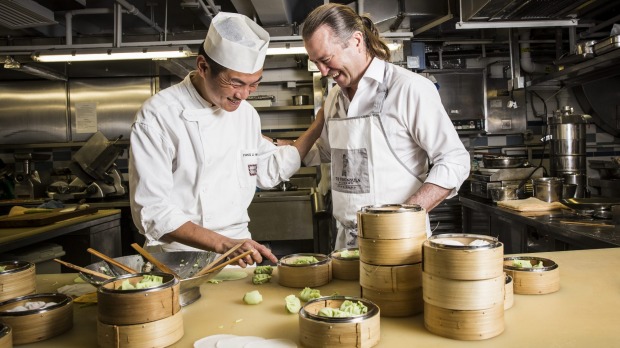
Making the perfect har gow is a fine art. The prawn-meat filling needs to be mixed and chopped to exactly the right consistency; the dough encasing it should be translucent but robust enough to hold the heavy little parcel together and not break when picked up with chopsticks; and the amount of meat should be generous, yet small enough that it can still be eaten in one bite.
What really separates the experts from the amateurs, however, is folding and pleating the dumplings. The best har gow have at least nine, and ideally 13 even pleats.
I'm in a dumpling-making class at The Peninsula Hong Kong under the tutelage of dumpling master Fong Li Hing. With his team of chefs, Chef Fong hand makes 1000 perfect dumplings each day that are served in the hotel's acclaimed Cantonese restaurant, Spring Moon. Neil Perry, arguably Australia's best-known chef, is my classmate. Call me competitive, but I'm completely delighted to note that I pleat a better har gow than him.
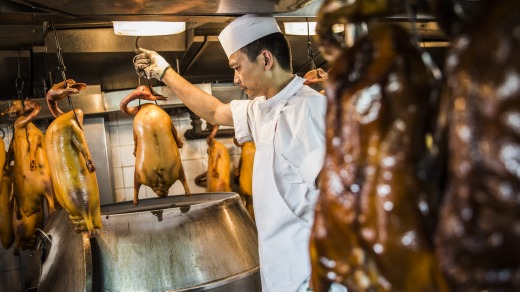
Perry, who has two Chinese eateries in his restaurant empire, is unfazed. "I don't have to be good at it. I have dumpling experts who work for me."
This is the first day of an exclusive tour of some of Perry's favourite food haunts in Hong Kong. We are about to learn how the city and its food have influenced Perry's restaurants, cookbooks and the inflight menu he designs for Qantas.
At Seventh Son (www.seventhson.hk) in Wan Chai on our first night, we're treated to a feast in 17 courses, with impeccably cooked Cantonese classics plus a few surprises. The reason most people come to Seventh Son, Perry tells us, is for its suckling pig. The dish lives up to its reputation, with skin so crisp it snaps like a cracker and meat that is tender, sweet and juicy. It's followed by chicken baked in rock salt. With golden, crunchy, salty skin, it immediately assumes its place as one of the two best roast chicken dishes I've ever eaten – and both were in Hong Kong.
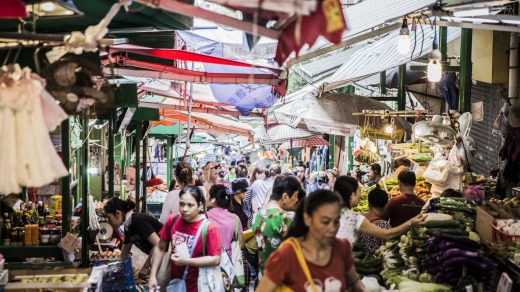
Our host, director Daniel Chui, regales us with stories of his family (who originally ran the famous Fook Lam Moon restaurants) and of his passion for "sustainability" in food production. Educated in the US, he's a vegetarian and our menu includes variations on classic Cantonese dishes where vegetables replace proteins.
We love hipster hangout Ho Lee Fuk (www.holeefookhk.tumblr.com ) in a Central basement, where Taiwanese-born, Sydney-trained chef Jowett Yu (who worked at Ms G's and Mr Wong) is rattling the woks. A wall of golden waving cats adds a pop-art feel to the entrance opposite the open kitchen. The menu is said to be inspired by the old school Hong Kong cha chaan teng (tea restaurants), with standout dishes including the roast wagyu short ribs served with fiery jalapeno puree, green shallot kimchi and soy glaze. Yu has adapted his mum's recipe for "Mostly Cabbage, Little Bit of Pork" dumplings, and the menu is complemented by an eclectic wine list that includes some interesting Japanese sakes.
The team behind the popular eatery are young expat entrepreneurs who run, among other ventures, Chom Chom (www.chomchom.hk), a Vietnamese-style bia hoi bar just across the street. We perch on upturned milk crates sipping themed cocktails such as the Pho-jito, made with rum, lemongrass, lime and mint, and a refreshing whisky-based Tamarind Sour. The neighbourhood, known as Soho (SOuth of HOllywood Road) is buzzing as drinkers and diners hop between the funky hole-in-the-wall establishments that line the narrow streets.
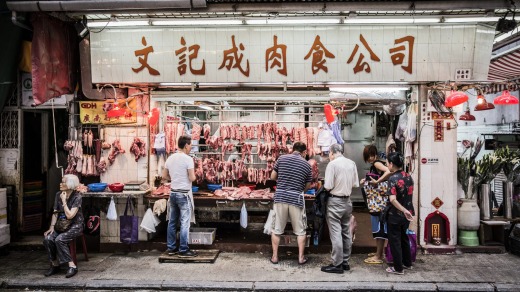
Aesthetics and design are phenomenally important to Hong Kong's new breed of restaurateurs. The eclectic fitout at Mott 32 (www.mott32.com) beneath an office block in Central celebrates Hong Kong culture and history. One wall is artfully decorated in traditional paint brushes. Service is a bit hit-and-miss, some dishes are under-seasoned and I can't help feeling it's style over substance, until we tuck into a textbook sweet and sour pork, the tangy sauce just lightly coating the meat. "It's perfect," Perry says. "So often it's swimming in sauce." Any reservations are banished for good when we taste the char siu, made from acorn-fed Spanish iberico pork. Marinated and barbecued, char siu is one of Canton's great gifts to the culinary world and Mott 32's sweet, nutty version is sublime.
Perry leads us through the wet markets of Central. Nestled among the butchers, fishmongers and fruit and veg stalls, are dai pai dongs, family-run, open-air street food stalls, with steaming cauldrons of soup and baskets of noodles that go into it. Once ubiquitous, they are slowly disappearing as the younger generations choose not to follow in their parents' footsteps and the licences lapse.
At the market stalls, Perry gets excited by the possibilities of ingredients we don't see every day at home: straw mushrooms, bitter melon and other gourds, snake beans and ginger, both young and old, which, he explains, local chefs use for different purposes.

Lung King Heen at the Four Seasons Hotel (www.fourseasons.com/hongkong) is the world's first Chinese restaurant to be awarded three Michelin stars and arguably the finest restaurant in the city. There's a three-month waiting list, so book well in advance.
Everything about Lung King Heen is stunning, from the view over Victoria Harbour to Kowloon, to the exquisite table settings. But it's the food that really impresses; wines from China, Korea and Taiwan and a Japanese Junmai Daiginjo Genshu sake are matched to each course. A single shrimp and crabmeat dumpling is served in its own individual steamer basket and topped with edible gold leaf. It's followed by a pair of dumplings, one with duck liver, scallop and vegetables, the other a classy xiao long bao, or Shanghai dumpling, filled with prawn, crab and a scalding aromatic broth.
The abalone coated with delicate jelly in the lightest puff pastry shell is the epitome of status-driven Cantonese cooking, but dish of the day is a single crab and black truffle spring roll, the pastry so fine it shatters on the tongue and dissolves in the mouth, the filling earthy but sweet.
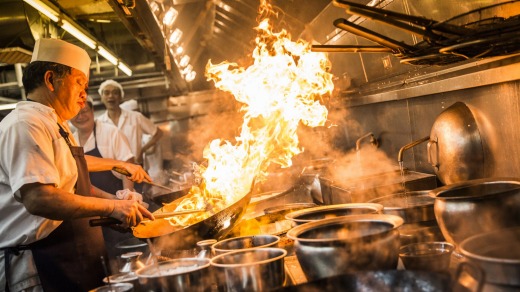
We return to more traditional fare, including blackened, jellied century eggs, at Yung Kee (www.yungkee.com.hk), in the heart of Central, which has been run by generations of the same family for 70 years. Roast goose is the house specialty, the bird with its dark caramelised skin served head and all, with wings splayed, as if it's just flown in and flopped on to the plate.
Even in this most traditional of Cantonese eateries, where shark's fin is served eight ways, there is a nod to progression and global trends. One of their most popular dumplings is a delicious vegetarian morsel stuffed with pumpkin, kale and quinoa, unlikely proof that, in the right hands, superfoods and Cantonese cooking can be a perfect match. The floors above the restaurant are home to the exclusive Kee Club, with a hip vibe, and frequented by Hong Kong's bright and beautiful, expat ladies who lunch, glamorous young professionals and creative types.
I try to draw Perry on the best dishes of the trip, but he doesn't like to single out one or two of the 70 or more we've eaten. "Why can't they all be favourites?" he says. "Why do I have to nominate just one. It's like asking a parent which is your favourite child." His passion and enthusiasm for Cantonese food is evident in every morsel gleefully stuffed into his mouth.
Indeed, for a chef who spends so much time in kitchens, he still gets excited about exploring other restaurants' kitchens and sampling their food. His response is simple: "If you love it, you love it."
www.discoverhongkong.com
Qantas has 21 non-stop flights a week to Hong Kong from Australia, including daily flights from Sydney, Melbourne, and Brisbane, with connections from all other Australian cities.
The Peninsula Hong Kong has a range of restaurants, bars and the famous Afternoon Tea in the Lobby. Add airport transfers in a chauffeur-driven Rolls Royce and it's bucket-list stuff. Double rooms from $630 a night; see hongkong.peninsula.com. The Peninsula Academy's dim sum making class costs $390 a person.
Self-taught cook Margaret Xu explores Hong Kong's culinary history and the multiple influences on the region's food, from Cantonese to Chiu Chow and Hakka. Marinated in spices and roasted for six hours in a terracotta oven she built herself, her Yellow Earth Chicken is the other perfect Hong Kong chicken dish. See yinyang.hk
Slightly sweet golden flaky pastry encases chunks of barbecued pork in a sweet, tangy sauce. These are yum cha staples city-wide but Tim Ho Wan, famous for being the first Michelin-starred eat-and-run restaurant in the world, does a particularly good version. See timhowan.com
Maxim's Palace City Hall is huge and a hugely popular yum cha eatery near IFC Mall in Central. Its shrimp wontons have a super-crisp casing and sweet juicy prawn filling. See maxims.com.hk
Perfect just-set custard in a very short pastry casing makes the egg custard tarts at Tai Cheong Bakery on Lyndhurst Terrace the stuff of legend. See taoheung.com.hk
Hong Kong breakfast doesn't come more authentic than a steaming bowl of noodle soup topped with a fried egg, spicy pork or braised chicken, and washed down with a mug of sweet milky tea, at a dai pai dong, family-run, open-air street food stalls.